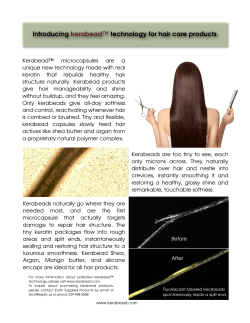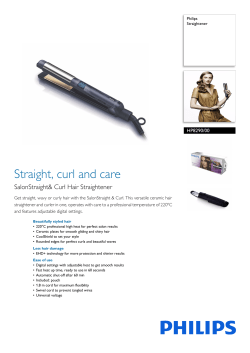
National Occupational Standards Unit GH13 Plait and twist hair
National Occupational Standards Unit GH13 Plait and twist hair What this unit is about This unit is about using plaiting and twisting techniques to achieve a variety of different looks. A high degree of manual dexterity will be necessary. The main outcomes of this unit are: 1. 2. 3. Maintain effective and safe methods of working when plaiting and twisting Plait and twist hair Provide aftercare advice Copyright © Habia 2008 Approved September 2008 www.habia.org Page 1 of 6 These standards are available for use in the UK only. If you wish to use them internationally please contact Habia for licensing availability. Unauthorised use may result in legal proceedings National Occupational Standards Unit GH13 Plait and twist hair What you must do (Performance Criteria) In order to perform this unit successfully you must: 1. Maintain effective and safe methods of working when plaiting and twisting by a) b) c) h) ensuring your client’s clothing is effectively protected throughout the service wearing personal protective equipment, if required positioning your client to meet the needs of the service without causing them discomfort ensuring your own posture and position whilst working minimises fatigue and the risk of injury keeping your work area clean and tidy throughout the service using working methods that minimise the risk of damage to tools minimise the wastage of products minimise the risk of cross-infection make effective use of your working time ensure the use of clean resources minimise the risk of harm or injury to yourself and others ensuring your personal standards of health and hygiene minimise the risk of crossinfection, infestation and offence to your clients and colleagues completing the plaiting and twisting service within a commercially viable time. 2. Plait and twist hair by a) confirming with your client the look agreed at consultation prior to and during the service controlling your tools to minimise the risk of damage to the hair and scalp, client discomfort and to achieve the desired look parting the sections cleanly and evenly to achieve the direction of the plait(s) and twists effectively securing any hair not being plaited or twisted to keep your section clearly visible maintaining a suitable and even tension throughout the service effectively controlling and securing your client’s hair throughout the plaiting and twisting processes, taking account of factors influencing the service applying suitable products, when necessary, at the right time in the process to achieve the style requirements consulting with your client during the service to ensure the tension is comfortable adjusting the tension of plaits and/or twists, when necessary, avoiding damage to the hair and minimising discomfort to your client ensuring the direction and balance of the finished plait(s) and/or twists achieves the desired look confirming your client’s satisfaction with the finished look. d) e) f) g) b) c) d) e) f) g) h) i) j) k) Copyright © Habia 2008 Approved September 2008 www.habia.org Page 2 of 6 These standards are available for use in the UK only. If you wish to use them internationally please contact Habia for licensing availability. Unauthorised use may result in legal proceedings National Occupational Standards Unit GH13 Plait and twist hair 3. Provide aftercare advice by a) b) giving advice and recommendations accurately and constructively giving your client suitable advice on the maintenance of their style and hair condition. Copyright © Habia 2008 Approved September 2008 www.habia.org Page 3 of 6 These standards are available for use in the UK only. If you wish to use them internationally please contact Habia for licensing availability. Unauthorised use may result in legal proceedings National Occupational Standards Unit GH13 Plait and twist hair What you must cover (Range) 1. Products are a) b) c) 2. Plaits and twists are a) b) c) d) e) 3. multiple cornrows French plait fishtail plait two strand twists flat twists. Factors are a) b) c) d) e) f) g) 4. sprays serums gels. hair density hair texture face and head shape hair elasticity hair length scalp condition desired look. Advice covers a) b) suitable home care products and their use how to remove plaits and twists. Copyright © Habia 2008 Approved September 2008 www.habia.org Page 4 of 6 These standards are available for use in the UK only. If you wish to use them internationally please contact Habia for licensing availability. Unauthorised use may result in legal proceedings National Occupational Standards Unit GH13 Plait and twist hair What you must know To perform this unit successfully, you will need to know and understand: Salon and legal requirements 1. 2. your salon's requirements for client preparation your own responsibilities under the current Control of Substances Hazardous to Health Regulations in relation to the use of products for plaiting and twisting How to work safely, effectively and hygienically when plaiting 3. 4. 5. 6. 7. 8. 9. 10. 11. 12. 13. what is contact dermatitis and how to avoid developing it whilst carrying out plaiting and twisting services the range of protective clothing that should be available for clients why it is important to use personal protective equipment the type of personal protective equipment available how the position of your client and yourself can affect the desired outcome and reduce fatigue and the risk of injury the importance of positioning equipment for ease of use why it is important to keep your work area clean and tidy methods of working safely and hygienically and which minimise the risk of crossinfection and cross-infestation the importance of personal hygiene methods of cleaning, disinfecting and/or sterilisation used in salons the importance of using bands for professional use Effects on the hair of plaiting and twisting 14. 15. 16. 17. the potential consequences of excessive tension on the hair what is traction alopecia how to identify the signs of traction alopecia the physical effects on the hair structure of plaiting and twisting Plaiting and twisting techniques 18. 19. 20. 21. 22. 23. 24. how hair texture affects the plaiting process and styling possibilities how to create cornrows, a French plait, two strand twists, fishtail plaits and flat twists the importance of sectioning hair accurately when plaiting and twisting methods of securing the completed plaits and twists how to handle the hair when plaiting and twisting to maintain a correct and even tension how to adjust the tension of plaits and twists how the factors in the range influence the choice and direction of plaited or twisted style Copyright © Habia 2008 Approved September 2008 www.habia.org Page 5 of 6 These standards are available for use in the UK only. If you wish to use them internationally please contact Habia for licensing availability. Unauthorised use may result in legal proceedings National Occupational Standards Unit GH13 Plait and twist hair Products and their use 25. 26. 27. 28. the types of products available for use with plaits and twists when and why you would use the types of products in the range the importance of using products economically the manufacturers’ instructions relating to the use of the products in the range Aftercare advice for clients 29. 30. 31. products for home use that will benefit the client and those to avoid and why how lifestyle can influence their choice of style (eg active sports, career and job requirements) the removal requirements for plaits and twists Communication 32. how to give effective advice and recommendations to clients. Copyright © Habia 2008 Approved September 2008 www.habia.org Page 6 of 6 These standards are available for use in the UK only. If you wish to use them internationally please contact Habia for licensing availability. Unauthorised use may result in legal proceedings
© Copyright 2025










